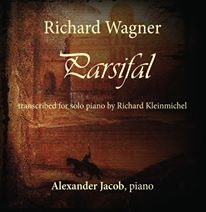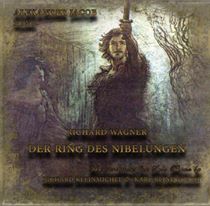Wagner for the piano - two excellent new Wagner recordings
by The Editor
Numen Books recently released two recordings of Wagnerian piano recitals by the intellectual historian Dr. Alexander Jacob. During the late nineteenth and early twentieth centuries, complete piano adaptations of Der Ring des Nibelungen and Parsifal intended for solo piano as well as duet, were made by composers like Richard Kleinmichel (1846-1901), Karl Klindworth (1830-1916) and Hermann Behn (1859-1927). It is especially satisfying therefore that solo piano transcriptions of these works have now been recorded by Alexander Jacob for Numen Books. They are valuable listening for all fans of Wagner's musical aesthetics and artistic vision.
Richard Wagner, Parsifal, transcribed for solo piano by Richard Kleinmichel, Alexander Jacob, piano, Numen Books, 2015.
Richard Wagner, Der Ring des Nibelungen, transcriptions for solo piano by Richard Kleinmichel and Karl Klindworth, Alexander Jacob, piano, Numen Books, 2015.
Of Richard Wagner's operatic works, the Ring cycle and Parsifal perhaps stand as his greatest musical achievements. Wagner’s deeply considered treatment of Norse and Teutonic legend in the former work is equalled by his exposition of the Arthurian Grail saga in the latter. While devotees and enthusiasts of Wagner regularly attend operatic performances of both works and undertake the pilgrimage to Bayreuth as well if they can, they may be less aware of piano interpretations of both these Wagnerian operas. During the late nineteenth and early twentieth centuries, complete piano adaptations of both operas, for solo piano as well as duet, were made by composers like Richard Kleinmichel (1846-1901), Karl Klindworth (1830-1916) and Hermann Behn (1859-1927). These transcriptions - unlike Franz Liszt's fantasies on Wagnerian scenes - are literal and complete. Recently, recordings of Hermann Behn's four-hand piano version of Das Rheingold and Die Walküre (played by Thomas Hoppe and Cord Garben, Dynaudio, 2013) and of Engelbert Humperdinck's four-hand version of Parsifal (played by Ana-Marija Markovina and Cord Garben, Gramola, 2014) have been made available. It is especially satisfying therefore that solo piano transcriptions of these works too have now been recorded by Alexander Jacob for Numen Books.
Born in India, Dr. Jacob received his PhD in the History of Ideas at Pennsylvania State University and his Licentiate Diploma in Piano from the Trinity College of Music, London. Intellectual historians may be familiar with Dr. Jacob's published works, including numerous translations of German ideological texts such as his two-volume translation of Edgar Julius Jung’s Die Herrschaft die Minderwertigen which provides English-reading audiences with a valuable document from Germany’s interwar Conservative Revolution movement. His own original works include Nobilitas: A Study of European Aristocratic Philosophy from Ancient Greece to the early Twentieth Century (2001) and De Naturae Natura: A Study of Idealistic Conceptions of Nature and the Unconscious (2011). Additionally, Dr. Jacob has also published The Grail: Two Studies (which includes his translation of Leopold von Schroeder’s Die Wurzeln der Sage vom Heiligen Gral (1911) along with Jacob’s original essay The Indo-European Origins of the Grail) for Numen Books in 2014. Both works in this Grail edition convincingly provide evidence of the pre-Celtic and pagan origins of the Grail myth.
Dr. Jacob’s personal fascination with Teutonic mythology and the Grail legend expresses itself in the selections he has made of the above-mentioned solo transcriptions in these excellent piano recordings. The Ring recording includes scenes from Die Walküre, Siegfried and Götterdämnerung. Dr. Jacob chose to use for this recording Kleinmichel’s transcriptions of the dramatic scenes and Klindworth’s transcriptions of the overtures. In Jacob’s Ring performance, the listener is struck by the pianist’s emphasis on the dramatic foci of this musical epic. Jacob opens the recording with the Prelude to the first Act of Die Walküre, the Sturmmuzik of Siegmund’s chase by the warrior Hunding. He continues with the tale of Siegmund and Sieglinde’s love and the spell cast on Brünnhilde by Wotan after Siegmund’s murder and the elevation of the wall of fire around Brünnhilde. Jacob’s manual dexterity is apparent especially in this final scene of Die Walküre which evokes both the creation of the magical circle of fire by Loki and the great sorrow of Wotan as he bids farewell to his sleeping daughter.
In the Siegfried section Dr. Jacob delineates the gradual maturation of Siegfried by playing in succession the preludes to all the three acts which depict, first, the forging of the sword Nothung, then the destruction of the dragon Fafnir, and finally Siegfried's fateful encounter with Wotan. Notable among these is Track V, the overture to the Second Act of Siegfried. The low menacing notes of the dragon’s cave and its serpentine movement are expertly expressed in the performance. Track VI brings the piano notes to a thunderous crescendo when Wotan challenges Siegfried to combat and the hero shatters the god’s spear with his sword Notung. Even though this is a solo piano performance rather than a full orchestra, Jacob's playing evokes all the drama of this scene of the young hero challenging the lord of Asgard and defeating him. The notes rise and descend with precise timing.
This technical proficiency continues in Jacob’s piano performance of Götterdämmerung. He begins with the murder of Siegfried by Hagen followed by a moving performance of Siegfried’s Funeral March. The last two tracks of the recording show Wagner at his best. Jacob’s playing here evokes the heroic and the tragic mood of this great operatic cycle through the flurrying notes depicting Brunnhilde’s immolation, the flooding of the Rhine, the Rhine maidens dragging Hagen to his death, and the final destruction of Wotan’s Valhalla. The listener is reminded here by Jacob’s technical proficiency of the extraordinary genius of Wagner that encapsulated in one consummate scene the heroic and tragic import of the entire epic Jacob's perfromance helps to open up this fate-ridden world to the listeners.
The same exegetical approach is to be noticed in Dr. Jacob’s piano performance of Parsifal. Here, the tone shifts from the heroic to one of sombre meditation. There are truly sublime passages throughout this performance and the selections from the three acts include the most agonising and spiritual scenes of Wagner’s final opera. Jacob's delicate use of pianissimo notes and his sensitive treatment of Wagner’s chromaticism assist him in capturing Wagner’s themes of Christian redemption and Grace. Track 1 contains the prelude to the first act of Parsifal in which the Sacred Service of the Grail is performed along with the presentation of the wounded king Amfortas. Track 2 beautifully conveys the magical transformation of the enchanted forest into the Castle of Montsalvat. This sense of esoteric transformation is conveyed again in Tracks V and VI, which contain the Prelude to Act II and Parsifal’s experiences in the sorcerer Klingsor’s magical garden. The final scene is brought to a climax in Track VI when Parsifal takes the Holy Lance and causes Klingsor’s false creations to sink beneath the earth. After the melancholic prelude to Act III in Track VII and the famous Good-Friday Music in Track VIII, Track IX concludes Dr. Jacob’s performance with the healing of Amfortas and Parsifal’s new enthronement as the immortal Grail-King. The power and drama of the Grail mythos is here given full pianistic expression, and the listener cannot fail to be moved by the music's sublime beauty.
As a great admirer of Wagner’s music, I found it amply rewarding to listen to Dr. Jacob's piano interpretations of the Ring cycle and Parsifal. I look forward to listening to them repeatedly in the future, as Dr. Jacob offers the listeners an opportunity to appreciate both the broad outlines and the details of Wagner's profound musical recreations of mediaeval Nordic and Celtic legends.

